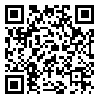Volume 10 - بهار 86-
mjms 2008, 10 - بهار 86-: 9-16 |
Back to browse issues page
Download citation:
BibTeX | RIS | EndNote | Medlars | ProCite | Reference Manager | RefWorks
Send citation to:



BibTeX | RIS | EndNote | Medlars | ProCite | Reference Manager | RefWorks
Send citation to:
Douzande J, Ravanshad M, Rasouli M, Sabahi F, Alborzi A. Development of Visual DNA Chip to Detect Human Immunodeficiency Virus type 1 Infection. mjms 2008; 10 :9-16
URL: http://mjms.modares.ac.ir/article-30-1615-en.html
URL: http://mjms.modares.ac.ir/article-30-1615-en.html
1- Department of Virology, School of Medical Sciences, Tarbiat Modares University, Tehran, Iran
2- Department of Immunology Research Center of Clinical Microbiology of Ostad Alborzi, Shiraz University of Medical Sciences, Shiraz, Iran
3- Research Center of Clinical Microbiology of Ostad Alborzi, Shiraz University of Medical Sciences, Shiraz, Iran
2- Department of Immunology Research Center of Clinical Microbiology of Ostad Alborzi, Shiraz University of Medical Sciences, Shiraz, Iran
3- Research Center of Clinical Microbiology of Ostad Alborzi, Shiraz University of Medical Sciences, Shiraz, Iran
Abstract: (10292 Views)
Objectives: Human Immunodeficiency Virus type 1 is the causative agent of Acquired Immunodeficiency syndrome “AIDS” in human and demonstration of HIV-1 genome in samples is accepted as evidence of infection. Transmission of Infection during window period in blood transfusion settings is a world wide concern. Also there is a need for a rapid, sensitive and accurate technique to detect HIV-1 infection prior to antibody appearance in patients and new borns.
Material and Method: A rapid Visual DNA Chip based on RT-Nested PCR and Enzyme-Substrate detection system was developed. At first a specific RT-Nested PCR was developed and the products were confirmed in gel electrophoresis and the products were labeled with DIG (Digoxigenin).
The labeled products were then hybridized with the pre-prepared chip with an anchored specific probe. After the washing procedure an antibody against DIG conjugated with alkaline phosphates enzyme was used. After the second washing procedure the BCIP/NBT substrate was used and development of color was interpreted as positive while the negative samples developed no color.
Results: 35 sera samples from different stages of HIV infection (AIDS, Asymptomatic and Symptomatic Infection) as well as 20 confirmed negative sera samples were collected and checked with the developed assay. All the positive samples developed reaction while the negative samples had no reaction.
Conclusion: In the current study the developed assay showed high sensitivity and specificity to detect HIV-1 infection. It seems that the viral genome could be detected prior to antibody appearance and hence the window period could be shortened. Also the assay could be used to detect infection in new borns from infected mothers, because the maternal antibody could pass the placenta and antibody based assay have false positive results. Because of the high sensitivity, the developed assay could also detect infection in very low viral load conditions.
Received: 2007/12/18 | Accepted: 2007/12/18
| Rights and permissions | |
 |
This work is licensed under a Creative Commons Attribution-NonCommercial 4.0 International License. |







